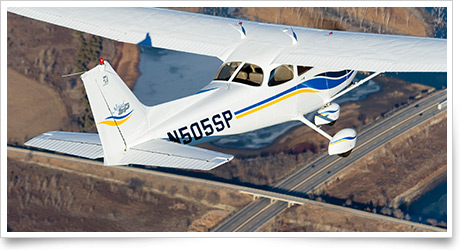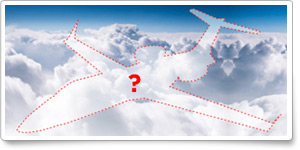|
|||||
Training TipsReport the road
Keep in mind that using pilotage to fly in urban environments can present different challenges than selecting and locating checkpoints did on other cross-countries. And because the communications component of flights into busy airspace takes on critical importance now, you may have to locate the proper checkpoint and then report your position as precisely as possible.
That will take great skill and care, with all those buildings, railroads, highways, and interchanges down there. Suppose you are approaching your destination from the west and have been instructed to report at 10 miles west when over a specific highway. Can you tell the many roads apart as they weave their way through the urban sprawl?
One pilot who misinterpreted an assigned reporting point—an error that resulted in an airspace incursion—concluded that “being relatively new to the area and unfamiliar with the terrain and landmarks” contributed to the error, the pilot said in a report to the Aviation Safety Reporting System (ASRS).
What about weather conditions? A pilot noted the contrasting presentations of a chart and the view from the cockpit in this August 2003 Flight Training magazine article:
“The haze rendered many details shown on the sectional chart difficult to pick up until we were relatively close. And, much of the detail that was visible through the haze was not depicted on the sectional chart. For example, there were many more roads than were shown on the chart.”
Studying aerial images and photos beforehand revealed “the true shape of the town, individual streets, identifiable buildings, parks, and baseball fields.”
Chapter 15 of the Pilot’s Handbook of Aeronautical Knowledge provides general guidance for selecting checkpoints, and introduces the technique called bracketing to keep you from straying from the desired track.
“If possible, select features that make useful boundaries or brackets on each side of the course, such as highways, rivers, railroads, and mountains,” it says. Flight Training NewsCirrus joins workforce-development partnershipA state-funded workforce development program in Minnesota may provide up to 60 employment opportunities at Cirrus Aircraft, where meeting production demands will require more assembly workers, the company said in a news release. Duluth, Minn.-based Cirrus announced a partnership with Lake Superior College to develop an aircraft assembly pre-employment program designed to prepare low-income applicants for assemblers’ jobs at the manufacturer of all-composite aircraft. Read more >> FAA to release easier-to-read notamsThe FAA Safety Team is advising pilots of several changes to the format of notices to airmen and the contractions used in notams. The revisions, which take effect Oct. 1, were “designed to harmonize the U.S. system” with International Civil Aviation Organization (ICAO) standards “and make notams more easily read,” the FAA said. Read more >> AOPA members share must-have appsLook up aircraft tail numbers, turn on your aircraft’s preheater remotely, check METARs and TAFs in their raw or easy-to-read format, and zip through Electronic Advance Passenger Information System with these “must have” apps recommended by AOPA members. Read more >> George Mason University starts flight training programNorthern Virginia’s George Mason University has expanded its offerings to include an aviation minor. Read more >> NJ aviation program expands to handle worker expansionThe aviation program at Paramus, N.J.-based Bergen Community College has added a full-time professor and chief pilot to help train students for aviation jobs, reports NJ.com. The college offers associate's degrees in aviation administration or aircraft operations. Speaking with Kentucky’s next generation of pilotsGlobalAir.com’s Ray Robinson had the chance to speak with three student pilots participating in the Kentucky Institute for Aerospace Education (KIAE), reports General Aviation News. KIAE works with 14 high schools in the state to provide students direct experiences in aeronautical engineering, flight, aircraft maintenance, and space systems. The three students were interviewed right before riding with a gathering of Yakovlevs at Bowman Field in Louisville, Ky. Making that judgment callOne of the toughest things for pilots of any experience level is determining whether the cloud levels and visibility conditions are safe for flight. It can take quite a bit of familiarity with the weather and its trends to make the call. Get a heads-up on this aspect of flight by taking the Air Safety Institute’s Weather Wise: Ceiling and Visibility online course. Log in to take the course >> More than mere wordsWritten with the safety of you and your passengers in mind, the federal aviation regulations (FARs) are not just a good idea to follow—they are the law. But that giant book can be a daunting task to read, so the Air Safety Institute has narrowed it down to some of the key points relevant to you. Learn more about the FARs by reading the Air Safety Institute's Federal Aviation Regulations Safety Advisor. Download the PDF >> Training Resources
|
||||||||||||||||||||||||||||||||||||
|
|||
AVIATION EVENTS & WEATHER
|
To include an event or to search all events in the calendar, visit AOPA Online. For airport details, including FBO fuel prices, see AOPA Airports. |
||||||||||||||
Final Exam
Question: As you approach your destination airport, you notice that the runway is very wet; a significant rain shower has recently passed. You vaguely remember something about the dangers of dynamic hydroplaning. At what speed does it occur?
Answer: The minimum speed at which dynamic hydroplaning will occur can be computed by multiplying the square root of the main landing gear tire pressure, in pounds per square inch, by nine. For example, the main landing gear tire pressure may be 36 psi. The square root of 36 is six, and six times nine equals 54. In this case dynamic hydroplaning could occur at a speed as low as 54 knots. Be aware that once dynamic hydroplaning starts, the condition can persist well below the minimum initial hydroplaning speed. For more information, see the Pilot’s Handbook of Aeronautical Knowledge. Got a question for our technical services staff? Contact AOPA. Instrument Tip
|
||||||||||||||
Flight Instructor Refresher Courses |
Air Safety Institute Safety Seminars |
|||||||||
For a complete schedule, see AOPA Online. Can’t make it in person? Sign up for the Air Safety Institute’s new Online eFIRC. |
Topics vary—for details and a complete schedule, see AOPA Online. |
|||||||||
|
ePilot Flight Training Editor: |
Contributors: |
Alton K. Marsh |
Production Team: |
Advertise in ePilot: South Central and Western: Zane Lewis, 214/789-6094 |
|
Member Tools: Send feedback | Update member profile/email | ePilot Flight Training Edition Archive Got news or questions? Contact ePilot. Having difficulty using this service? Visit the ePilot Frequently Asked Questions online at AOPA.org or contact us. |
||||

 The cross-country phase is an exciting stage of flight training that pushes back the boundaries of your aviation universe, builds your endurance, and offers a taste of your aircraft’s capabilities as a traveling machine. Flights to varied destinations expose you to quiet strips or buzzing terminals—and may take you through numerous airspace classes. (For operations in Class B airspace and at airports located within Class B airspace, make sure you
The cross-country phase is an exciting stage of flight training that pushes back the boundaries of your aviation universe, builds your endurance, and offers a taste of your aircraft’s capabilities as a traveling machine. Flights to varied destinations expose you to quiet strips or buzzing terminals—and may take you through numerous airspace classes. (For operations in Class B airspace and at airports located within Class B airspace, make sure you  When a new aircraft arrives on the scene, plane spotters rejoice at the opportunity to add a new model to their repertoire and note distinctive spotting features. This year, bizjet manufacturer Dassault Falcon celebrates its fiftieth anniversary, and is quite literally
When a new aircraft arrives on the scene, plane spotters rejoice at the opportunity to add a new model to their repertoire and note distinctive spotting features. This year, bizjet manufacturer Dassault Falcon celebrates its fiftieth anniversary, and is quite literally 


